Reza Arablouei
Backdoor Mitigation via Invertible Pruning Masks
Sep 19, 2025Abstract:Model pruning has gained traction as a promising defense strategy against backdoor attacks in deep learning. However, existing pruning-based approaches often fall short in accurately identifying and removing the specific parameters responsible for inducing backdoor behaviors. Despite the dominance of fine-tuning-based defenses in recent literature, largely due to their superior performance, pruning remains a compelling alternative, offering greater interpretability and improved robustness in low-data regimes. In this paper, we propose a novel pruning approach featuring a learned \emph{selection} mechanism to identify parameters critical to both main and backdoor tasks, along with an \emph{invertible} pruning mask designed to simultaneously achieve two complementary goals: eliminating the backdoor task while preserving it through the inverse mask. We formulate this as a bi-level optimization problem that jointly learns selection variables, a sparse invertible mask, and sample-specific backdoor perturbations derived from clean data. The inner problem synthesizes candidate triggers using the inverse mask, while the outer problem refines the mask to suppress backdoor behavior without impairing clean-task accuracy. Extensive experiments demonstrate that our approach outperforms existing pruning-based backdoor mitigation approaches, maintains strong performance under limited data conditions, and achieves competitive results compared to state-of-the-art fine-tuning approaches. Notably, the proposed approach is particularly effective in restoring correct predictions for compromised samples after successful backdoor mitigation.
Countering Backdoor Attacks in Image Recognition: A Survey and Evaluation of Mitigation Strategies
Nov 17, 2024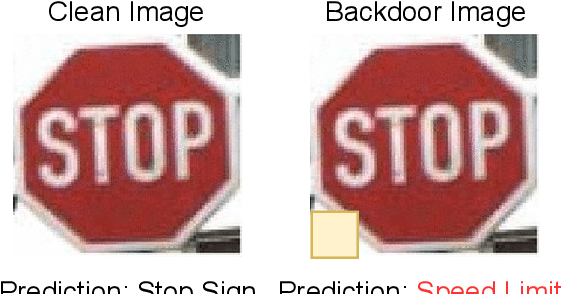
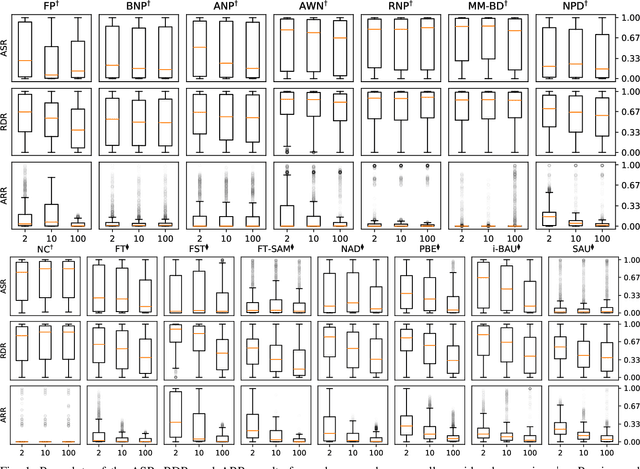

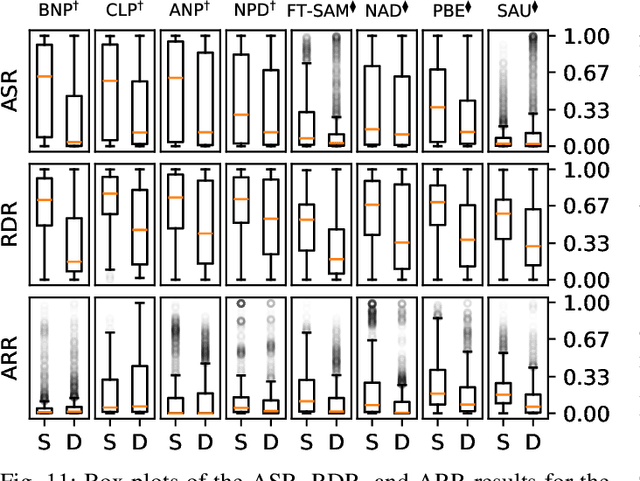
Abstract:The widespread adoption of deep learning across various industries has introduced substantial challenges, particularly in terms of model explainability and security. The inherent complexity of deep learning models, while contributing to their effectiveness, also renders them susceptible to adversarial attacks. Among these, backdoor attacks are especially concerning, as they involve surreptitiously embedding specific triggers within training data, causing the model to exhibit aberrant behavior when presented with input containing the triggers. Such attacks often exploit vulnerabilities in outsourced processes, compromising model integrity without affecting performance on clean (trigger-free) input data. In this paper, we present a comprehensive review of existing mitigation strategies designed to counter backdoor attacks in image recognition. We provide an in-depth analysis of the theoretical foundations, practical efficacy, and limitations of these approaches. In addition, we conduct an extensive benchmarking of sixteen state-of-the-art approaches against eight distinct backdoor attacks, utilizing three datasets, four model architectures, and three poisoning ratios. Our results, derived from 122,236 individual experiments, indicate that while many approaches provide some level of protection, their performance can vary considerably. Furthermore, when compared to two seminal approaches, most newer approaches do not demonstrate substantial improvements in overall performance or consistency across diverse settings. Drawing from these findings, we propose potential directions for developing more effective and generalizable defensive mechanisms in the future.
Unlearning Backdoor Attacks through Gradient-Based Model Pruning
May 07, 2024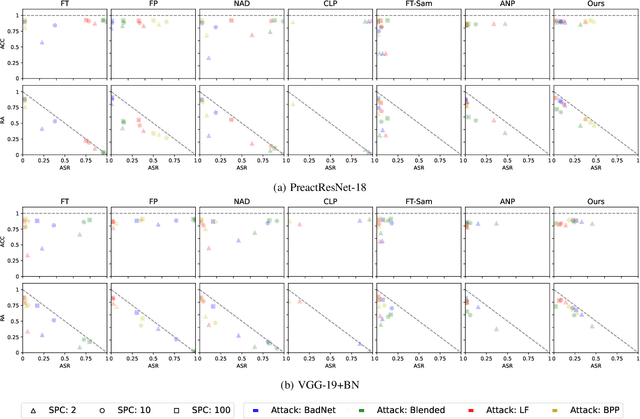
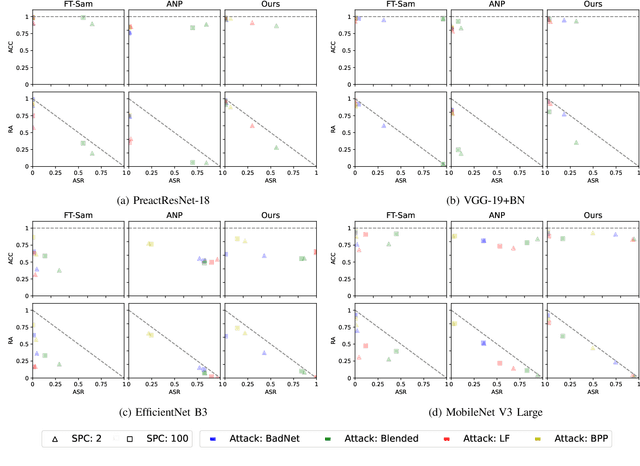
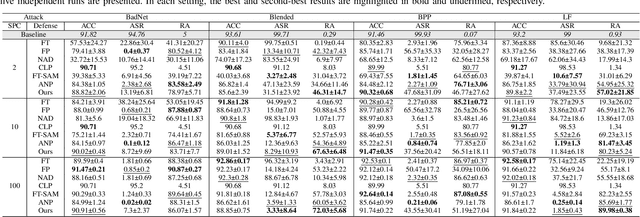
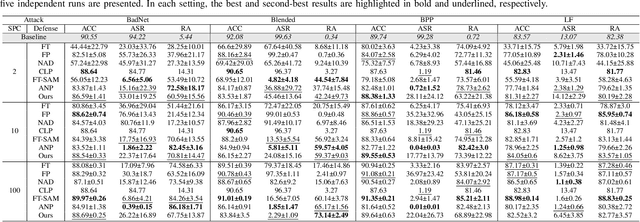
Abstract:In the era of increasing concerns over cybersecurity threats, defending against backdoor attacks is paramount in ensuring the integrity and reliability of machine learning models. However, many existing approaches require substantial amounts of data for effective mitigation, posing significant challenges in practical deployment. To address this, we propose a novel approach to counter backdoor attacks by treating their mitigation as an unlearning task. We tackle this challenge through a targeted model pruning strategy, leveraging unlearning loss gradients to identify and eliminate backdoor elements within the model. Built on solid theoretical insights, our approach offers simplicity and effectiveness, rendering it well-suited for scenarios with limited data availability. Our methodology includes formulating a suitable unlearning loss and devising a model-pruning technique tailored for convolutional neural networks. Comprehensive evaluations demonstrate the efficacy of our proposed approach compared to state-of-the-art approaches, particularly in realistic data settings.
Distributed Maximum Consensus over Noisy Links
Mar 27, 2024



Abstract:We introduce a distributed algorithm, termed noise-robust distributed maximum consensus (RD-MC), for estimating the maximum value within a multi-agent network in the presence of noisy communication links. Our approach entails redefining the maximum consensus problem as a distributed optimization problem, allowing a solution using the alternating direction method of multipliers. Unlike existing algorithms that rely on multiple sets of noise-corrupted estimates, RD-MC employs a single set, enhancing both robustness and efficiency. To further mitigate the effects of link noise and improve robustness, we apply moving averaging to the local estimates. Through extensive simulations, we demonstrate that RD-MC is significantly more robust to communication link noise compared to existing maximum-consensus algorithms.
Privacy-Preserving Distributed Nonnegative Matrix Factorization
Mar 27, 2024
Abstract:Nonnegative matrix factorization (NMF) is an effective data representation tool with numerous applications in signal processing and machine learning. However, deploying NMF in a decentralized manner over ad-hoc networks introduces privacy concerns due to the conventional approach of sharing raw data among network agents. To address this, we propose a privacy-preserving algorithm for fully-distributed NMF that decomposes a distributed large data matrix into left and right matrix factors while safeguarding each agent's local data privacy. It facilitates collaborative estimation of the left matrix factor among agents and enables them to estimate their respective right factors without exposing raw data. To ensure data privacy, we secure information exchanges between neighboring agents utilizing the Paillier cryptosystem, a probabilistic asymmetric algorithm for public-key cryptography that allows computations on encrypted data without decryption. Simulation results conducted on synthetic and real-world datasets demonstrate the effectiveness of the proposed algorithm in achieving privacy-preserving distributed NMF over ad-hoc networks.
Analyzing the Impact of Partial Sharing on the Resilience of Online Federated Learning Against Model Poisoning Attacks
Mar 19, 2024Abstract:We scrutinize the resilience of the partial-sharing online federated learning (PSO-Fed) algorithm against model-poisoning attacks. PSO-Fed reduces the communication load by enabling clients to exchange only a fraction of their model estimates with the server at each update round. Partial sharing of model estimates also enhances the robustness of the algorithm against model-poisoning attacks. To gain better insights into this phenomenon, we analyze the performance of the PSO-Fed algorithm in the presence of Byzantine clients, malicious actors who may subtly tamper with their local models by adding noise before sharing them with the server. Through our analysis, we demonstrate that PSO-Fed maintains convergence in both mean and mean-square senses, even under the strain of model-poisoning attacks. We further derive the theoretical mean square error (MSE) of PSO-Fed, linking it to various parameters such as stepsize, attack probability, number of Byzantine clients, client participation rate, partial-sharing ratio, and noise variance. We also show that there is a non-trivial optimal stepsize for PSO-Fed when faced with model-poisoning attacks. The results of our extensive numerical experiments affirm our theoretical assertions and highlight the superior ability of PSO-Fed to counteract Byzantine attacks, outperforming other related leading algorithms.
Real-time Multi-modal Object Detection and Tracking on Edge for Regulatory Compliance Monitoring
Oct 05, 2023Abstract:Regulatory compliance auditing across diverse industrial domains requires heightened quality assurance and traceability. Present manual and intermittent approaches to such auditing yield significant challenges, potentially leading to oversights in the monitoring process. To address these issues, we introduce a real-time, multi-modal sensing system employing 3D time-of-flight and RGB cameras, coupled with unsupervised learning techniques on edge AI devices. This enables continuous object tracking thereby enhancing efficiency in record-keeping and minimizing manual interventions. While we validate the system in a knife sanitization context within agrifood facilities, emphasizing its prowess against occlusion and low-light issues with RGB cameras, its potential spans various industrial monitoring settings.
IoT Data Trust Evaluation via Machine Learning
Aug 15, 2023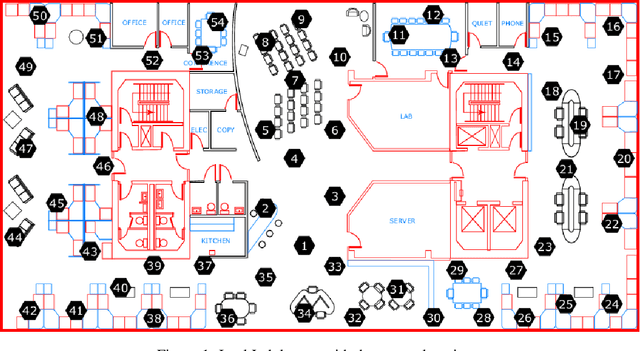
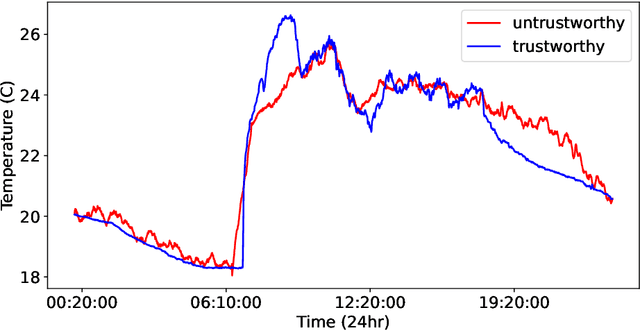
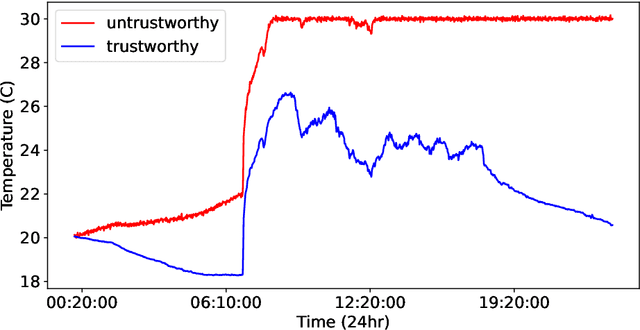
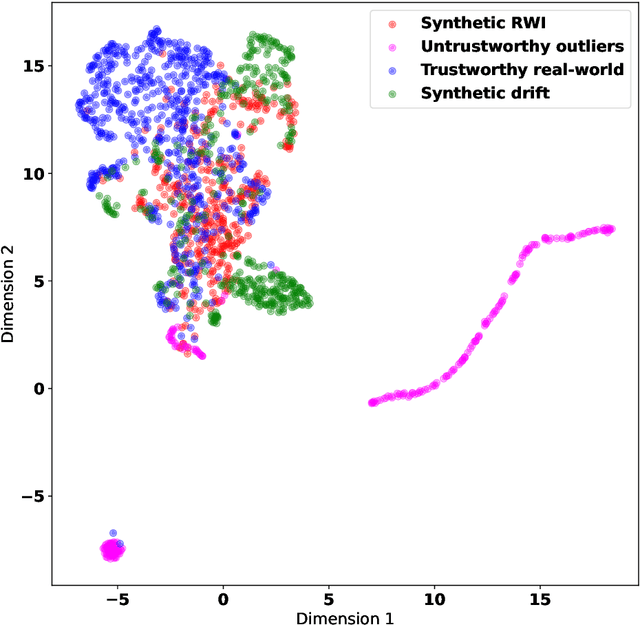
Abstract:Various approaches based on supervised or unsupervised machine learning (ML) have been proposed for evaluating IoT data trust. However, assessing their real-world efficacy is hard mainly due to the lack of related publicly-available datasets that can be used for benchmarking. Since obtaining such datasets is challenging, we propose a data synthesis method, called random walk infilling (RWI), to augment IoT time-series datasets by synthesizing untrustworthy data from existing trustworthy data. Thus, RWI enables us to create labeled datasets that can be used to develop and validate ML models for IoT data trust evaluation. We also extract new features from IoT time-series sensor data that effectively capture its auto-correlation as well as its cross-correlation with the data of the neighboring (peer) sensors. These features can be used to learn ML models for recognizing the trustworthiness of IoT sensor data. Equipped with our synthesized ground-truth-labeled datasets and informative correlation-based feature, we conduct extensive experiments to critically examine various approaches to evaluating IoT data trust via ML. The results reveal that commonly used ML-based approaches to IoT data trust evaluation, which rely on unsupervised cluster analysis to assign trust labels to unlabeled data, perform poorly. This poor performance can be attributed to the underlying unsubstantiated assumption that clustering provides reliable labels for data trust, a premise that is found to be untenable. The results also show that the ML models learned from datasets augmented via RWI while using the proposed features generalize well to unseen data and outperform existing related approaches. Moreover, we observe that a semi-supervised ML approach that requires only about 10% of the data labeled offers competitive performance while being practically more appealing compared to the fully-supervised approaches.
CVB: A Video Dataset of Cattle Visual Behaviors
May 26, 2023

Abstract:Existing image/video datasets for cattle behavior recognition are mostly small, lack well-defined labels, or are collected in unrealistic controlled environments. This limits the utility of machine learning (ML) models learned from them. Therefore, we introduce a new dataset, called Cattle Visual Behaviors (CVB), that consists of 502 video clips, each fifteen seconds long, captured in natural lighting conditions, and annotated with eleven visually perceptible behaviors of grazing cattle. We use the Computer Vision Annotation Tool (CVAT) to collect our annotations. To make the procedure more efficient, we perform an initial detection and tracking of cattle in the videos using appropriate pre-trained models. The results are corrected by domain experts along with cattle behavior labeling in CVAT. The pre-hoc detection and tracking step significantly reduces the manual annotation time and effort. Moreover, we convert CVB to the atomic visual action (AVA) format and train and evaluate the popular SlowFast action recognition model on it. The associated preliminary results confirm that we can localize the cattle and recognize their frequently occurring behaviors with confidence. By creating and sharing CVB, our aim is to develop improved models capable of recognizing all important behaviors accurately and to assist other researchers and practitioners in developing and evaluating new ML models for cattle behavior classification using video data.
Point-Syn2Real: Semi-Supervised Synthetic-to-Real Cross-Domain Learning for Object Classification in 3D Point Clouds
Oct 31, 2022



Abstract:Object classification using LiDAR 3D point cloud data is critical for modern applications such as autonomous driving. However, labeling point cloud data is labor-intensive as it requires human annotators to visualize and inspect the 3D data from different perspectives. In this paper, we propose a semi-supervised cross-domain learning approach that does not rely on manual annotations of point clouds and performs similar to fully-supervised approaches. We utilize available 3D object models to train classifiers that can generalize to real-world point clouds. We simulate the acquisition of point clouds by sampling 3D object models from multiple viewpoints and with arbitrary partial occlusions. We then augment the resulting set of point clouds through random rotations and adding Gaussian noise to better emulate the real-world scenarios. We then train point cloud encoding models, e.g., DGCNN, PointNet++, on the synthesized and augmented datasets and evaluate their cross-domain classification performance on corresponding real-world datasets. We also introduce Point-Syn2Real, a new benchmark dataset for cross-domain learning on point clouds. The results of our extensive experiments with this dataset demonstrate that the proposed cross-domain learning approach for point clouds outperforms the related baseline and state-of-the-art approaches in both indoor and outdoor settings in terms of cross-domain generalizability. The code and data will be available upon publishing.
 Add to Chrome
Add to Chrome Add to Firefox
Add to Firefox Add to Edge
Add to Edge